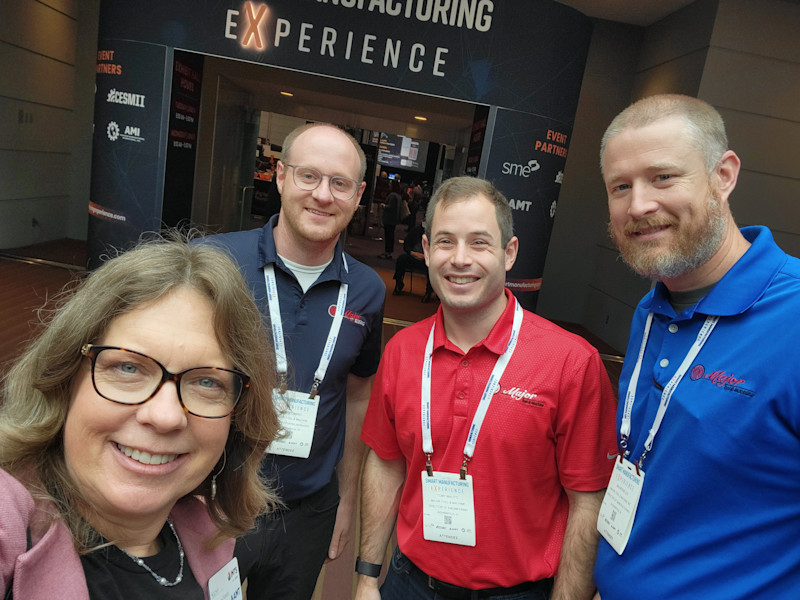Many agree the one thing manufacturers make more of than anything else is data. And this data is valuable – helping us create greater efficiencies by reducing waste and downtime, work more productively, and ultimately giving us a better ROI. Early this summer, forward-thinking manufacturers gathered at the Smart Manufacturing Experience (SMX) to explore how to capture and leverage this data to work smarter. Sponsored by SME and AMT – The Association For Manufacturing Technology, the event took place at the David L. Lawrence Convention Center in Pittsburgh, a hub of smart manufacturing, AI, and robotics in the United States. Smart Manufacturing Experience brought together operational manufacturing technologists, business owners, and technology providers, fostering collaboration aimed at transforming manufacturing through the adoption of smart digital technologies. “We are interested in digital work instructions, training, digital factory, and incorporating AI into our environment,” said Brandon Lee, director of manufacturing at Major Machine Tool in Indianapolis, In., when asked about his reasons for attending. “The Smart Manufacturing Experience was a great opportunity to get some exposure to new technology and see some examples of what other companies are doing in our industry.” SMX featured a number of new technologies manufacturers can implement now to prepare for the future. Five highlights from SMX include:
1. Meet “Murray,” an AI bot. Mursix Corporation plant manager Joe Barr introduced their company’s newest technology designed to help employees troubleshoot various challenges. This app sounds like a friendly seasoned employee, even a kind uncle – the kind we wish we all had when a home appliance breaks. Murray answers questions, offers suggestions, and even knows where employees can find tools and knobs. Murray is quite the example of how manufacturing companies are leveraging AI to retain and automate the valuable knowledge of retiring employees to boost workforce performance and productivity. Named after the company's founder, Murray gathers insights from seasoned staff, watches experts perform routine tasks, stores this information, and allows anyone to ask for specific procedures or machinery operations. By listening through headphones, users receive step-by-step guidance from Murray. Additionally, Murray uses machine learning to enhance its responses and suggest alternative solutions. This system ensures that essential knowledge is preserved for new employees. Mursix is collaborating with Purdue University to develop similar AI initiatives for other manufacturers. Murray’s ability to breakdown complex questions, remain patient, and real-life sounding voice was pretty darn cool. Barr closed with two important reminders:
Technology has the potential to reduce gaps we have in our industry.
People are still the key to our success, and they are our most valuable resource.
2. A riveting story about grounding Black Hawks. Todd Royar, vice president and program integrator lead for Textron, Inc., told a cringing account of how he dealt with a failing part in active Black Hawks while he was the commanding general of U.S. Army Aviation and Missile Command. Based on his experience, to resolve the issue, he offered recommendations to small and medium-sized companies for integrating advanced manufacturing capabilities with the Department of Defense and Large OEMs. Recommendations included:
1. Know Product Lifecycle Management. 2. Be proficient in Step files. 3. Plan for Traceability.
4. Understand quality control contracting operations.
5. Consider like machines.
6. Ask questions.
7. Develop company culture with education, incentives, and publicizing successes.
8. Demand ROI.
3. Virtual reality (VR) to reduce costly snafus. Eric Kam, senior product marketing manager at the ESI Group, demonstrated the use of virtual environments to design manufacturing systems before a product launch. Creating a virtual manufacturing line to simulate the entire production process identifies potential bottlenecks and inefficiencies before the physical setup. The simulation can also enhance serviceability by allowing designers to virtually experience the product. In one instance, designers using virtual reality assessed the placement of grab bars that were too high and bulkheads that were too low. Designers refined the design to improve reach and usability.
4. Strategies for implementing robots. Jennifer Apicella, executive director at Pittsburgh Robotics Network interviewed Julie Gulick of Bally Design about successfully implementing robots in the session “Increasing Predictability for Success – Driving Transformation and Change in Manufacturing at SMX.” Gulick offered some great advice for implementing automation which focused on the theme of “small.” As in, start with a small coachable team, focus on solving one small problem, make progress with attainable (small) steps and goals, don’t aim for perfection, and keep making small steps to keep momentum going. They closed with a thoughtful metaphor, when dealing with robotic implementation, “think of yourself as a thermostat, not a temperature taker.”
5. Making Connections.
“Curious and friendly” best describe the crowd at SMX. Some people were even carrying parts. Plenty of people were networking throughout the floor. It seems smart manufacturers want to make connections. As my friend and colleague Rick Neff, 3D printing influencer, says, “collaboration makes for innovation.” Neff should know, he was part of the team to build the world’s first ever 3D printed car at IMTS 2024.
A big hit hosted by SMX exhibitor Pittsburgh Robotics Network included a well-attended reception at Aurora, a Pittsburgh-based company that develops self-driving vehicle technology including semi-trucks. Jennifer Apicella, executive director at Pittsburgh Robotics Network, welcomed more than 100 guests. The sleek Aurora semi-truck proved a popular photo opp and talking point.
“SMX brought together manufacturers who are eager to adopt smart digital technologies,” says Dave Morton, SME group director- events. “Technologies like additive manufacturing, virtual reality, automation/robotics, and areas including cybersecurity, data analytics, and workforce transformation address specific pain points to heighten operational efficiency, reduce costs, improve quality control, and foster cybersecure environments, while at the same time addressing the talent shortage.”
Your next chance to explore the world of manufacturing smart technologies is at IMTS 2024, Sept. 9-14, at McCormick Place in Chicago. Register at IMTS.com/Register.
Among the 1200 IMTS exhibitors will be special displays showcasing the future of manufacturing in the AMT Emerging Technology Center (IMTS booth #236700) and the SME Innovations in Workplace (IMTS booth #236900).






